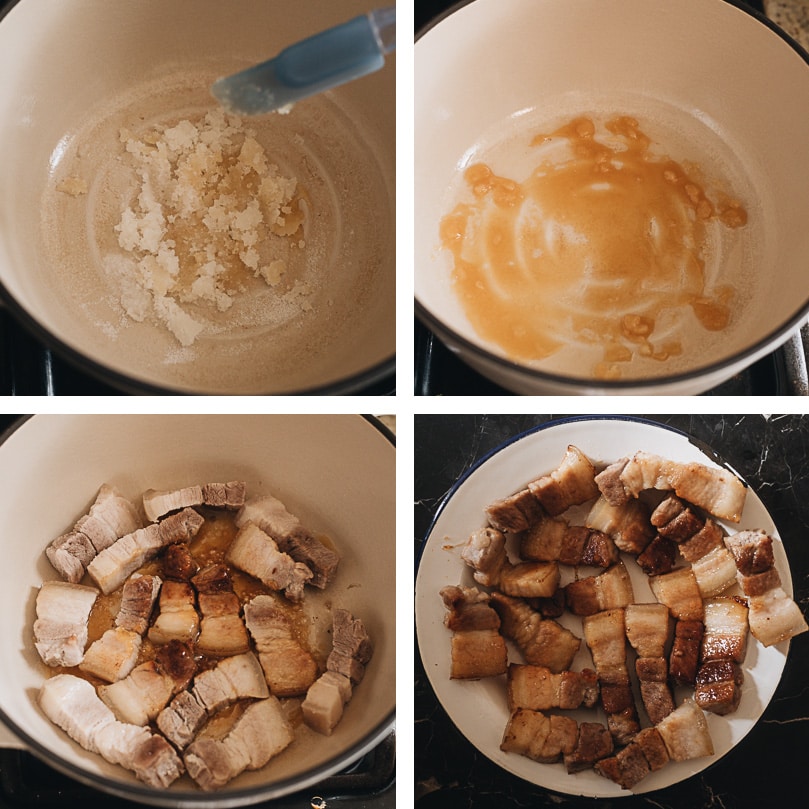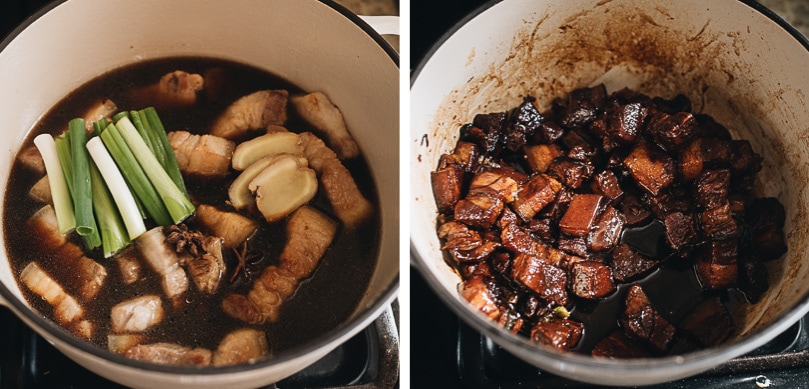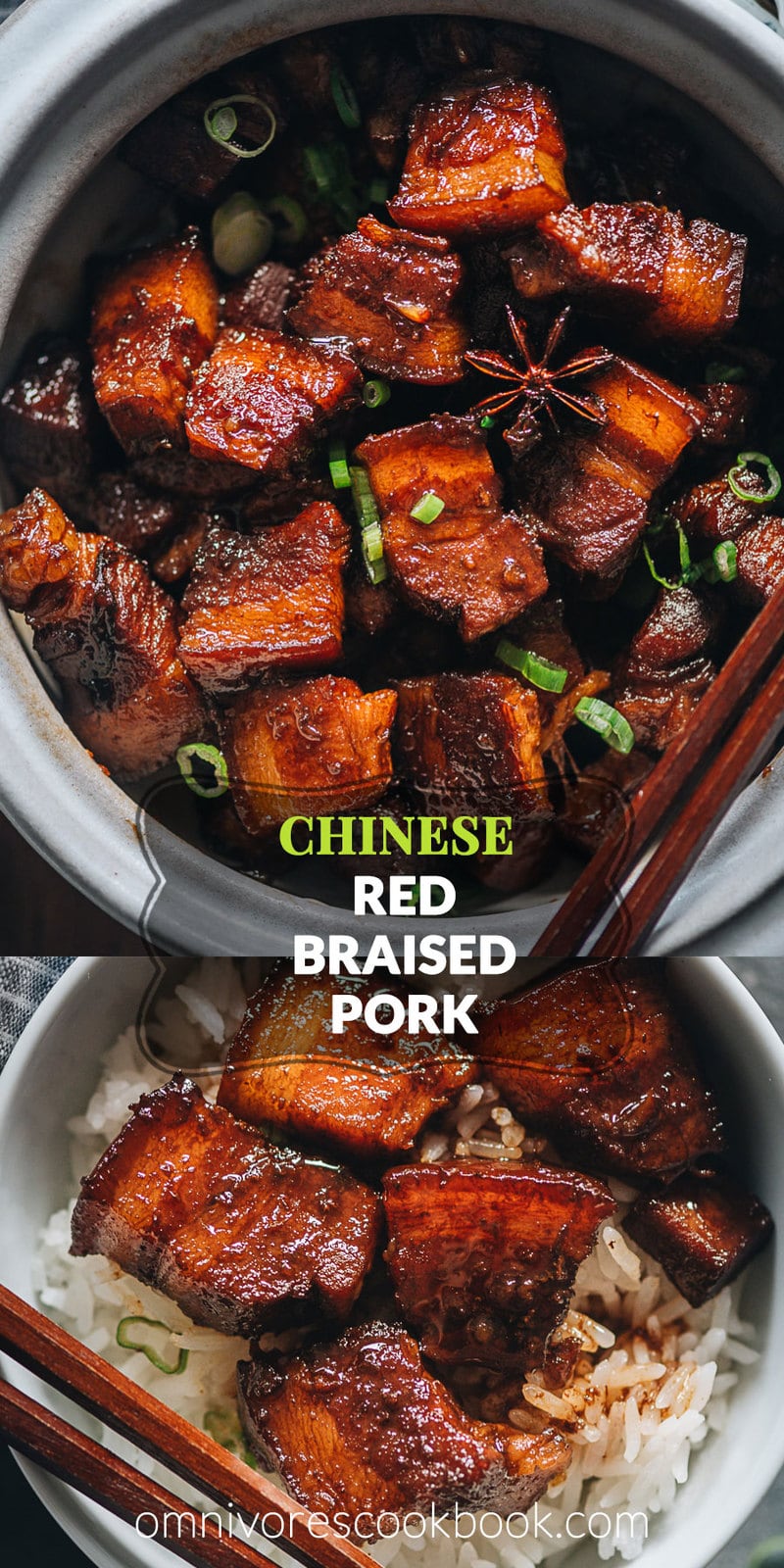Hong Shao Rou is a Chinese classic. The tender, juicy pork is coated in a glossy sauce that is sticky, savory, sweet, and full of fragrance. It’s a perfect dish to cook on a weekend and enjoy throughout the week.

Hong Shao Rou, or red braised pork, is a beloved dish in China. Depending on the region, there are many different approaches to cooking it. Some versions taste sweeter, some taste more savory, while others taste spicy. However, all of them use the red braise cooking method to give the pork a glossy caramelized char. The pork is then simmered in liquid with Shaoxing wine, soy sauce, and plenty of aromatics until melt-in-your-mouth tender.
In the past I shared how my family braises pork. For example, the Northern Chinese style Braised Pork Ribs and Braised Pork Feet. The Hong Shao Rou recipe I’m sharing today is closer to Shanghai style, which is the more popular version in the US.
I can’t wait to show you how easy it is to cook this dish in your own kitchen!

Cooking notes
1. How to purchase pork belly
The authentic red braised pork always uses skin-on pork belly. You can usually find it in a Chinese market. I’ve even seen gorgeous cuts of pork belly at Costco. Personally, I always pick the leanest cut I can find, so the final version is less greasy. If you don’t like pork skin, the skinless type also works well. Most Korean and Japanese markets sell skinless pork belly. Some US grocery stores sell the cut too, but it tends to be very fatty at those places.
2. How to cut pork belly
Pork belly shrinks quite a bit during cooking. I prefer to cut it into 1” (2.5 cm) chunks, so it will absorb flavor well while holding its shape. Note, depending on the cut you get, the best shape to cut it into might be a rectangle (see the picture below). I got this sliced pork belly in Chinatown. I would cut them into long rectangles instead of further cutting them into squares. It’s important to leave the lean meat attached to the fat, so the meat will become extra tender from the braising.

Cooking process
1. Blanching the pork
This step is very important in most Chinese braised pork dishes. It gets rid of the impurities from the pork and imparts the meat with aromatics. The cooking liquid is reserved and used at the braising.
All you need to do is:
- Cover the pork with water and cook it with the aromatics
- Skim the foam from the surface
- Rinse the pork with cold tap water to further remove the impurities
- Drain and dry the pork thoroughly with paper towels (very important – it will prevent splatter when you cook the pork in the hot sugar)

2. Sear the pork in sugar (炒糖色)
It’s a technique used in many red braised dishes. By melting sugar in oil, then cooking the pork in the syrup that results, the pork will be browned immediately with a beautiful caramel color. It will add depth of flavor and give the pork that shiny look at the end of the cooking.
While the method might sound daunting, it’s actually quite easy. All you need to do is to ensure that you dry the pork thoroughly and use a pot without any water on it. So it won’t cause any splatter.
- Sprinkle the sugar in the pan and add the oil
- Cook until the sugar melts and the color is amber
- Brown the pork in the melted sugar
- You might need to brown the pork in two batches depending on the size of the pan

3. Braising
The easiest part!
- Add the browned pork, the braising liquid, and the aromatics.
- Braise until the broth is reduced to a thick glossy sauce and the pork is tender.

Side dishes to serve with
Hong Shao Rou is a very rich dish. Consider pairing it with steamed rice and leafy vegetables to create a balanced meal. Some side dishes that go well with it include:
- 4-Ingredient Baby Bok Choy Stir Fry
- Chinese Pickled Cabbage (A Quick Pickle Recipe)
- Easy Chinese Cucumber Salad
- Chinese Seaweed Salad
- Stir-Fried Pea Shoots with Garlic
This red braised pork also holds up very well and is freezer-friendly. Make it ahead and portion it out, so you can have delicious feasts throughout the busy week!

More delicious make-ahead recipes
- Chinese Chili (Sichuan Style)
- Char Siu (Chinese BBQ Pork)
- African Chicken (Macanese One-Pan Chicken Curry)
- Chinese Beef Stew with Potatoes
- Mom’s Best Braised Pork Ribs
If you give this recipe a try, let us know! Leave a comment, rate it (once you’ve tried it), and take a picture and tag it @omnivorescookbook on Instagram! I’d love to see what you come up with.

Hong Shao Rou (Red Braised Pork, 红烧肉)
Ingredients
- 1.5 to 2 lbs (700 to 900 g) pork belly , cut into 1” (2.5 cm) cubes
Blanching Liquid
- 2 green onions , cut into 2” (5 cm) pieces
- 1/2" (1 cm) ginger , sliced
Braising Liquid
- 2 tablespoons peanut oil (or vegetable oil)
- 3 tablespoons sugar
- 1/3 cup Shaoxing wine (or dry sherry)
- 2 cups reserved blanching liquid
- 3 tablespoons light soy sauce (or soy sauce)
- 1 1/2 tablespoons dark soy sauce
- 1" (2 cm) ginger , sliced
- 3 green onions , cut into 2” (5 cm) pieces
- 2 whole star anise pods
Instructions
- In a medium-sized pot add the pork belly and enough water to cover it completely. Make sure there is some space between the water level and the lip of the pot to avoid boiling over and to make skimming easier.
- Add the green onions and ginger. Cook over high heat until the water reaches a full boil. Boil for 5 minutes, using a fine mesh strainer (or a ladle) to skim and discard the brown foam from the top, until the liquid is clear.
- Strain the pork and reserve the blanching liquid. Rinse the pork with running tap water to stop the cooking and rinse away any scum that may have stuck to it.
- In a separate medium-sized dutch oven or pot (make sure it is completely dry to avoid the oil and sugar splattering), add the sugar and oil. Heat over low heat until the sugar is melted and begins to brown; look for an amber color. Try to avoid stirring the sugar while melting it. Instead, swirl the whole pot.
- Once the caramel is a light amber color, carefully add the pork chunks by gently placing them into the caramel to minimize splashing or splattering. Depending on the size of your pot, you might need to add the pork in two batches.
- Turn the heat up to medium-low and brown the pork in the caramel, about 1 minute on each side. Be careful not to burn the sugar.
- Add the cooking wine and scrape with a wooden spatula to release any brown bits from the bottom of the pan. Add the reserved blanching liquid, light soy sauce, dark soy sauce, ginger, green onions, and star anise.
- Turn to medium-high heat until the broth comes to a boil. Turn to medium-low or low heat so the broth reduces to a simmer. Cover the pot, leaving a finger-width gap to allow the steam to escape. Simmer for 1 hour and 30 minutes. Stir 2 to 3 times during the simmering.
- If the pork has turned tender but the sauce isn’t fully reduced, remove the lid and bring the heat up to medium. Cook for another 10 or 15 minutes, until the liquid is reduced to a glaze consistency. Keep an eye on the pot during the process and stir to prevent burning on the bottom.
- Serve the pork with the glaze over steamed rice as a main course.
- You can store the leftovers in a sealed container in the fridge for 4 to 5 days or in the freezer for a month. To reheat the frozen pork, thaw it in the fridge overnight, then steam it until fully heated through, 15 to 20 minutes. If you want to reheat the pork in the microwave, cover the bowl with a plate to prevent oil splatter.
Nutrition
Lilja Walter is a part of the Omnivore’s Cookbook team and worked closely with Maggie to develop and test this recipe.














Made exactly as written. Absolutely delicious on top of Thai jasmine rice with a vegetable stir fry on the side. Fortunately we have several very large Asian supermarkets in our city so there is a great selection of pork belly and pretty much everything you could desire that is asian! Thanks for your wonderful suggestions and easy to understand recipes.
Hi Ernest, I’m so happy to hear you like the recipe and thanks for sharing your feedback!
Happy cooking and have a great day 🙂
Have you tried making this using tofu instead?
I just made this recipe and wanted something that was still jam-packed flavourful — and this was it!! Thank you Maggie 🙂
This sounds absolutely phenomenal. Can’t wait to make some of these scrumptious recipes
As a non Chinese Singaporean living in Europe, I look for authentic recipes. This is one of my go-to website. I make this dish at least once a month. My family loves it! Thank you!
Hi Maggie! Can you suggest a method to cook this without using sugar? I’m trying to minimize carbohydrates from my diet. Anyway awesome website— I’m a fan of your recipes!
Hi Yasmin, I would skip the browning pork with sugar (step 5 and 6). Once you blanched the pork, add it with the rest braising ingredients (without the oil and sugar), then simmer until the pork turns tender. However, I highly recommend adding a small amount of sugar to the braising liquid (2 teaspoons or so), so it balance the flavor and create a much better taste.
Totally forgot to mention. If you decide to add a small amount of sugar to the braising liquid, you can try using unrefined coconut sugar. It has a lower GI and it’s a bit healthier than cane sugar.
This recipe makes an excellent hong shao rou that hasn’t missed with a single person I’ve served it to. It can convert Americans away from using pork belly only for bacon. We have a small Asian store nearby that often carries pork belly with the skin on. When they’re out, I go to the butcher who always has pork belly, more often than not with the skin on.
Just made this and it was super delicious! Thanks Maggie! The only thing I changed was pouring the sauce into a gravy separator to separate off the fat before reducing it at the end. I think I must have had an especially fatty pork belly because there was lots of fat and the sauce didn’t seem like it was going to reduce properly without removing it.
Just got around to doing this one after spotting it on Instagram a while back (social distancing time user-upper). The sauce when reduced was delicious on the pork, sweet and salty with the anise notes. I used a slow cooker, blanched the pork belly whole using then Sear function for 10 miniyes, then cubed the partially cooked belly. I made the sugar glaze using the Sear function, then reduced the heat to brown the belly. I added all the braising ingredients to the browned pork, cooked covered on Low for 2 hours, then used 180 deg heat to reduce the cooking liquid to a glaze. Looking forward to having the leftovers with steamed bao and coriander tomorrow. Thanks Maggz!
Followed your recipe and cooked a mouth watering melt in your mouth braised pork belly! It was so good and definitely worth the time! It did take awhile for my sugar to caramalize but I think that’s because I use an induction stove…
I followed the recipe (which I don’t usually manage to do), and the result was incredibly rewarding. Thumbs up from the wife and me!
Thanks for the great recipe.
Thank you for the recipe! We enjoyed it! My sugar melting went kind of weird, sugar didn’t melt for a long time so I turned the heat to medium until it starts to look brown (my first time of doing this, maybe my stove isn’t as hot to be able to melt sugar at low heat) but it still turned out great! Thanks again!
Same thing happened to me! Would be helpful if the recipe included a time frame to melt the sugar so I’m not just getting impatient and turning the heat up.
My father used to make this and sometimes he would add squid. It was my favorite. He passed away 9 months ago and I’m so glad I found you and this recipe! I can’t wait to try it. Thank you!
Such a delicious recipe! I used pork belly from Costco, as suggested, and the result was magnificent. I served it with bok choy, mushrooms and jasmine rice.
Hi Maggie, love this recipe, so very delicious!!! Can I replace all of the sugar with coconut sugar?
Yes you can!
What about using rock sugar?
You totally can. But it might be harder to melt with less oil (like in this recipe). If using rock sugar, it would be easier to use a wok and a bit more oil, so the sugar is submerged in the oil and easier to melt.
Hi,
I made this to the letter, and it was truly outstanding. Thank you for sharing your knowledge.
WOW! The flavour in this recipe was intense and delicious! It tasted very similar to the versions I ate in China and it was very easy to prepare. Unfortunately we could only find a relatively fatty cut of pork belly but tried the recipe anyway. I was worried that the texture would be off but somehow this created perfectly rendered meat! I had to have my husband move the bowl to the other side of the table so I would stop eating it!
In full transparancy I messed this recipe up (user error). With that being said, the pork still tastes good and we’ll still eat it. I ended up with no glaze – my caramel wasn’t right even after redoing it so by the time I reduced the glaze I was left with 1.5 cups of pork fat + dark chunks of nonrendered what I’m assuming is sugar. Since I want a glaze, do you think I could just make a small recipe of the sauce, sprinkle in a bit of sugar then reduce that down to serve with the pork?
When reheating, what are you steaming in? Wok, bamboo steamer, instant pot? I was thinking about trying to reheat in my air fryer then tossing with a bit of new flaze
I think maybe you didn’t cook the sugar properly at the beginning. But if you reduce the broth enough, it should form a thick sauce that glaze the pork. It will look less shiny without the cooked sugar, but should still be a glaze.
You can totally cook a small batch of the sauce for glazing, as long as the pork doesn’t taste too salty for you after the second batch of sauce.
For reheating, my favorite way is to reheat in a bamboo steamer. It will keep the pork very tender without drying out.
That being said, if you prefer a crispy result and do not mind the pork being dry out a bit, an air fryer might be the way to go.
Oh my goodness, this meal brings back so many childhood memories. I loved it as a child and love it even more as an adult! Thank you so much for reminding me about this dish!
another great recipe thank you, very helpful about selecting the pork belly for this dish too, thank you!
I made the mistake of raising the heat at the end in an attempt to thicken the sauce (we were hungry!) which in turn melted the fat in the pork belly which left the lean meat swimming in a sea of hot boiling fat. I managed to save it in time, but just barely. Next time I’ll just lengthen the braising time or scoop the meet out before attempting to reduce the sauce. Despite nearly burning it up, it still tasted amazing!